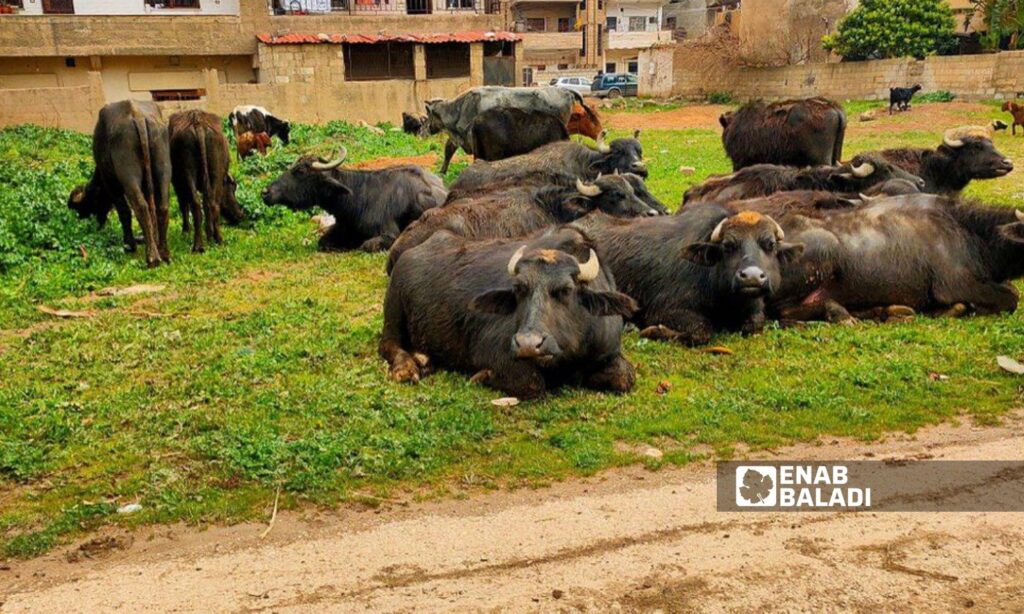Al-Hasakah – Majd al-Salem
On the outskirts of the city of Qamishli, and in part of the al-Tai neighborhood, buffalo breeders insist on maintaining their profession as a primary and inherited source of income, providing for dozens of families. This area is now known as the “al-Jammaseh” neighborhood, named after buffalo breeding.
Mohammad Hawija (46 years old), one of the buffalo breeders from Qamishli, told Enab Baladi that buffalo breeding is considered the primary and sole source of income for his family, which has long been accustomed to this profession, making it difficult to find an alternative despite the challenges facing this line of work.
Hawija owns about eight heads of buffaloes, which he tends in a single herd with other animals from breeders in the neighborhood, to lighten the burden and effort.
Drought increases difficulties
Drought is the “enemy” of buffaloes, according to Hawija, who explained that buffaloes love lush green areas abundant with water where rivers are found.
He added that the buffalo sheds were built decades ago on the banks of the Jaghjagh river in Qamishli, as they enjoy entering the river and swimming in it, especially during the summer with rising temperatures.
The breeder pointed out that all of this has now changed, as the river has become dry most of the year, and during the summer, it turns into a swamp where sewage water accumulates, causing diseases to the buffaloes.
Hawija mentioned that the drought has forced breeders to rely on buying their feed privately, noting that the price per kilogram of bran is 2500 Syrian pounds, and the price of straw is 1800 Syrian pounds, considering that one buffalo consumes between 75 and 100 kilograms of feed in just two days.
In contrast, official entities allocate between 100 and 150 kilograms of feed for each buffalo every 11 months, according to the breeder.
Some breeders are forced to migrate with their buffaloes to the banks of the Euphrates River in Raqqa in search of green spaces and water at the beginning of summer, Hawija said, noting that moving with buffaloes is exhausting and tiring, and there are security risks related to the road, “so this option is not always available.”
Other breeders informed Enab Baladi that space constraints in al-Hasakah are one of the obstacles to breeding buffaloes, which are large animals that need spacious pens, and some might find them “intimidating because of their size” while breeders assure that they are gentler and more friendly than cows.
“Geymar” is a reason for the continuation of their breeding
Each buffalo produces about six kilograms of milk daily, which is less than the production rate of cows, as mentioned by Mohammed Hawija and other breeders to Enab Baladi. However, it is very creamy and is used to make cheese, yogurt, and clotted cream (Geymar).
However, “Geymar” is considered the main product that breeders rely on for profit and to continue breeding buffalo. The price per kilogram of “Geymar” reaches 100,000 Syrian pounds, and every ten kilograms of buffalo milk produces one kilogram of “Geymar.”
“Geymar” along with honey and hot bread forms a delicious and famous breakfast meal in Qamishli over the years, according to Essa Shalabi (50 years old), who works at one of the “Geymar and honey” restaurants in the “Turks” market in the center of Qamishli.
Shalabi said that a breakfast of “Geymar and honey” costs 25,000 Syrian pounds per person, and customers come from different places and even from other provinces, buying quantities of “Geymar” for personal consumption or as valuable and expensive gifts for friends.
There is no official census on the number of buffaloes in areas under the control of the Autonomous Administration of North and East Syria (AANES), although some are found in Qahtaniyah and Malikiyah but less so than in Qamishli.
In September 2023, the Ministry of Agriculture in the Syrian regime’s government stated that the total number of buffaloes in all of Syria amounts to 6,500 heads, with 4,900 heads in “safe areas,” a term referring to areas under the regime’s control.

